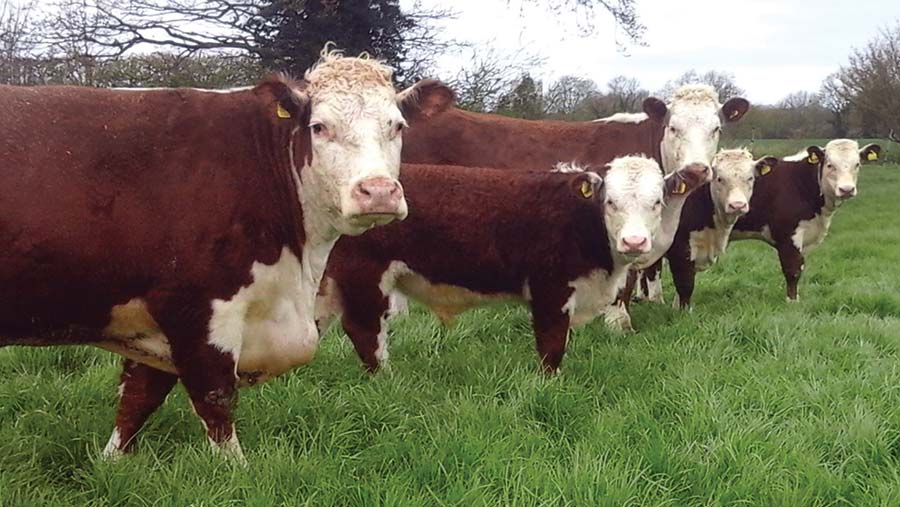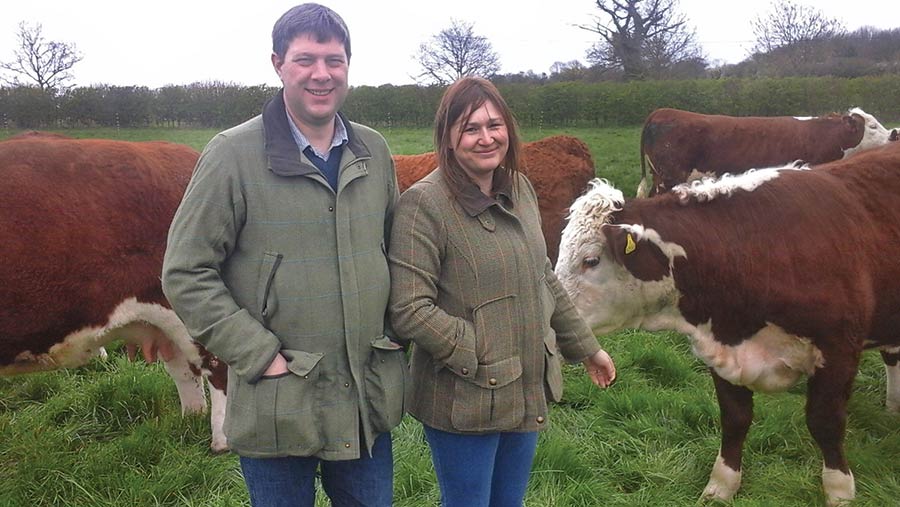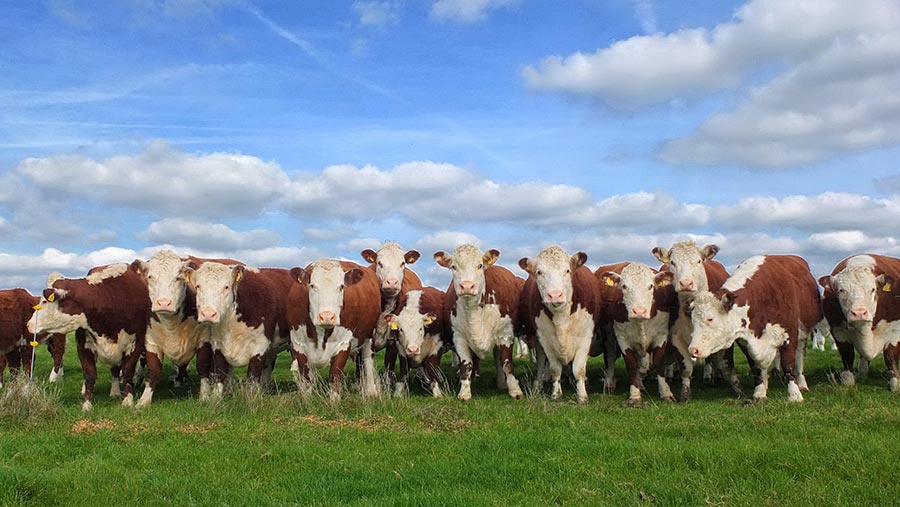How absolute beginners achieved Hereford breed excellence
It’s hard to believe that Norfolk farmers Philip and Laura Vincent were newcomers to beef breeding when they set up their pedigree Pulham herd – as in a very short time theirs has become one of the highest-ranked herds in the breed.
The couple, who farm at White House Farm, Diss, Norfolk, in partnership with Philip’s parents, Robert and Sandra, established the Pulham Hereford herd with four horned Hereford cows.

Farm revenue comes largely from the family’s chicken egg business, which Mr Vincent set up in 2003 on his return from agricultural college in Lincolnshire.
Four years later, they set up the Hereford herd, filling the void left by a pig-rearing operation, which the family got out of over fears salmonella could spread across the yard to their chicken units.
“Our income was mainly from the poultry, so we had to make a decision on what to do with the pigs,” he says. “We expanded the poultry and got rid of the pigs, which gave us a shed to put some cattle in. That’s where the Herefords started, in the old pig shed.”
With no cattle experience between them, the Vincents chose the Hereford breed for its docility and ease of calving.
“Somebody rented the land around the chicken sheds from us and they had a commercial herd – and within that they had some Herefords. We had seen that they were quiet, knew they were easy to manage, they were native, and fed on grass,” says Mrs Vincent.
“And easy-calving because we didn’t have the experience,” Mr Vincent adds. “Rather than a continental, which might be slightly more difficult to calve, the Hereford seemed like a perfect choice for us.”
See also: Native beef breeds drive 2015 calf birth increase
Eight years on, the herd has grown to 35 horned and polled Hereford cows, about 40% of which are ranked among the top 10% of the national Hereford herd for terminal index EBV.
This includes Clipston Tiara R16 – the 2015 Horned Female of the Year – which is in the top 10% of the Hereford breed for her self-replacing index (SRI), terminal sire index (TSI), 400- and 600-day weights, and 200-day milk production figures.
They also secured the 2015 Horned Bull of the Year title, which is awarded to the animal that has gained the most number of points from a maximum of five qualifying events during the show season.
The Vincents, who don’t buy cattle at market, attribute the success of the herd partly to their early buying decisions.

“We were very selective about the animals that we purchased,” says Mrs Vincent.
Using a selection of Hereford breed journals, they began their search for cattle to establish their herd’s foundations.
They stumbled upon an article by Colin Clarke, the now-retired farm manager of the Badlingham herd, which Mrs Vincent considers to have “one of the best-known female lines in horned breeding”.
At the time the Vincents were getting into Herefords, the Badlingham herd was owned by AG Wright & Sons, with Robert Clarke, Colin’s son, as the stockman. “We went there and picked four females – that’s where it all started, that’s where our interest took off,” Mrs Vincent says. “We were very keen to purchase Blossoms [bloodlines], and we managed to purchase one in the original four.”
When an opportunity to purchase another Blossom from the Badlingham herd arose, they jumped at the chance.
“Robert sold us Blossom 142, and she has been our best animal,” she says. “Looking back, that one female has had a very profound effect on the herd.”
Bloodlines
The Vincents “use EBVs as a tool” when adding cows to the herd, but ultimately base any decision on the bloodline and maternal traits of an animal.
“When we are researching, we look at what they have done. Where have their progeny gone? How did their progeny sell? Did their progeny sell to another pedigree herd, and did it then breed a bull that sold to a pedigree herd? How long did they keep it? Did it have 10 calves? Did it have two? Did they get rid of it?
“If we go somewhere to look at an animal, we have already been on the Breedplan database. It’s not just about going, looking at it and liking the look of it. It’s about looking into the animal’s breeding history and what that line has done,” she adds.
When adding females to the herd, the Vincents also take into account:
- Temperament
- Mothering ability
- Milk production
- Finishing ability
- Thickness across the top
With bulls, EBVs are taken into account to a greater extent at the point of purchase.
“When you are putting an animal across the whole of your herd, you don’t want it to have any big faults because they are going to get through your herd,” says Mr Vincent, adding that length is a characteristic they are currently hoping to improve in the herd.

Calving
The Vincents calve in autumn (September, October and November) and spring (January, February and March).
Heifers are at first calved at 30 months, with the best females – about 10 of the 35-strong herd – AI’d, often using semen with an Australian influence, in the hope of producing something unique.
“One of those calves turned out really well last year and we sold it at nine months for a considerable amount of money,” says Mr Vincent, adding that conception rates among AI’d cows vary from 30% to as high as 60%.
See also: Step-by-step practical guide to using AI in your spring-calving beef herd
The rest of the herd are put to one of the Vincents’ three stock Hereford bulls.
Those selected for AI that don’t hold are put to the bull three weeks later. Conception is achieved “99%, if not 100% of the time, if we put the bull in”, says Mr Vincent.
Cattle are turned out in late April and stay out until November or early December.
While indoors, cows subsist on a diet of bale silage, supplemented with minerals. Meanwhile, youngstock are fed a coarse mix of wheat, barley, oats and minerals “to keep them moving on”.
Cows calve indoors and calves are weaned at 8-10 months.
Bulls are scanned for eye muscle and fat. They are kept intact until their 200-day weight has been recorded, with the best kept or sold. The rest are usually finished at 13-15 months as bulls, or castrated and finished as steers at 18-20 months and tend to grade R4L.
Steers usually weigh in at 600-650kg and heifers at 550-600kg liveweight, with animals typically killing out at 56-57%.
The Vincents select based on female lines, growth and conformation – keeping the best for themselves and selling the rest as breeding females “as long as they are good enough”.
“On the female side, we tend to select on female lines and how well they have grown and on their conformation,” says Mr Vincent.
“Everything has our name on it, so it’s no good selling something that’s not good enough. So we select the best animals to sell or keep and finish everything else.”
They sell up to four animals boxed each year; the rest go direct to the abattoir.
Farm revenue
While farm revenue still largely comes from the chicken business, income from the sale of cows and bulls is increasing.
“In the financial year that has just finished we sold about £50,000-worth of cattle, which to us is really good. Every year, we are moving up, selling more and more, which is good because it shows we are promoting well and getting more and more of a name.”
See also: Five steps to a more profitable beef industry
The herd also complements the 28,000-strong chicken business, says Mr Vincent.
“At the time of building our free-range layer shed, we needed 1ha of grass per 1,000 birds. When we first started we had this field, which is 13ha, which means we could have 12,000 or 13,000 chickens. But it meant we had all this grass, which the chickens don’t eat,” he says.
“If we didn’t have the cattle, we would probably have to cut it for silage.”
“It also helps to draw the chickens out of the shed to range,” he adds.
Farm Facts
- Third-generation family farm
- 72ha, including 50ha grass and 22ha arable, which is rented out on a “straw for muck” basis
- 35 breeding cows, three stock bulls
- Calving in autumn (September, October and November) and spring (January, February and March)
- Four or five bulls a year are sold for breeding – mostly from March to May
- 28,000 chickens
- Shareholder in Anglia Free Range Eggs
- Elite member of the SAC Premium Cattle Health Scheme, with risk 1 level for Johne’s
- Situated in a TB4 (four-yearly testing) area
- Accredited free from bovine viral diarrhoea (BVD), infectious bovine rhinotracheitis (IBR) and leptospirosis
